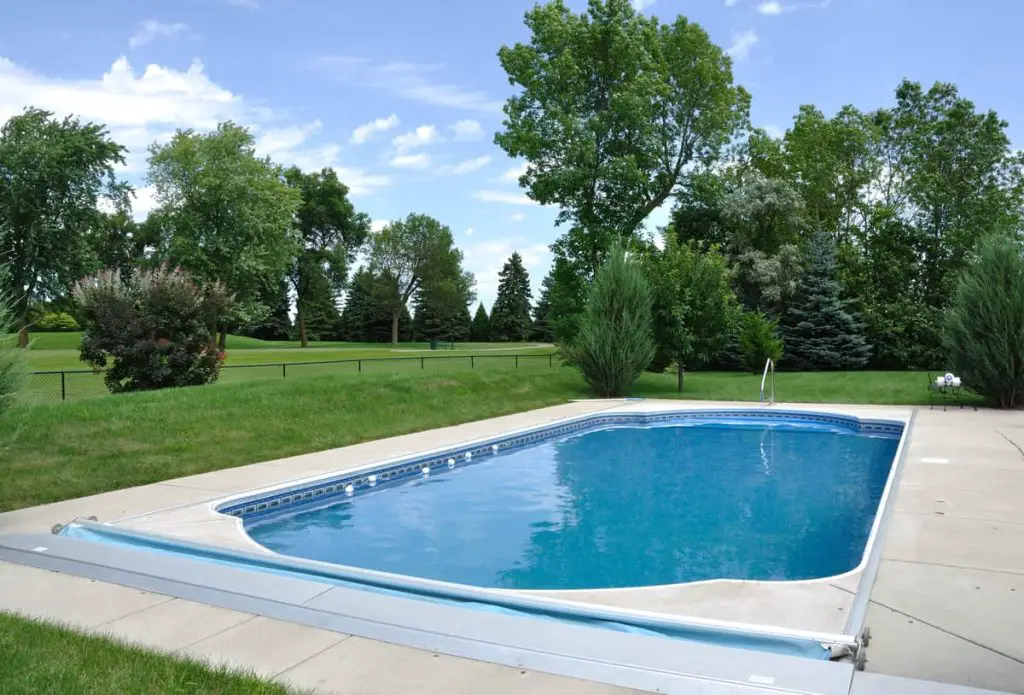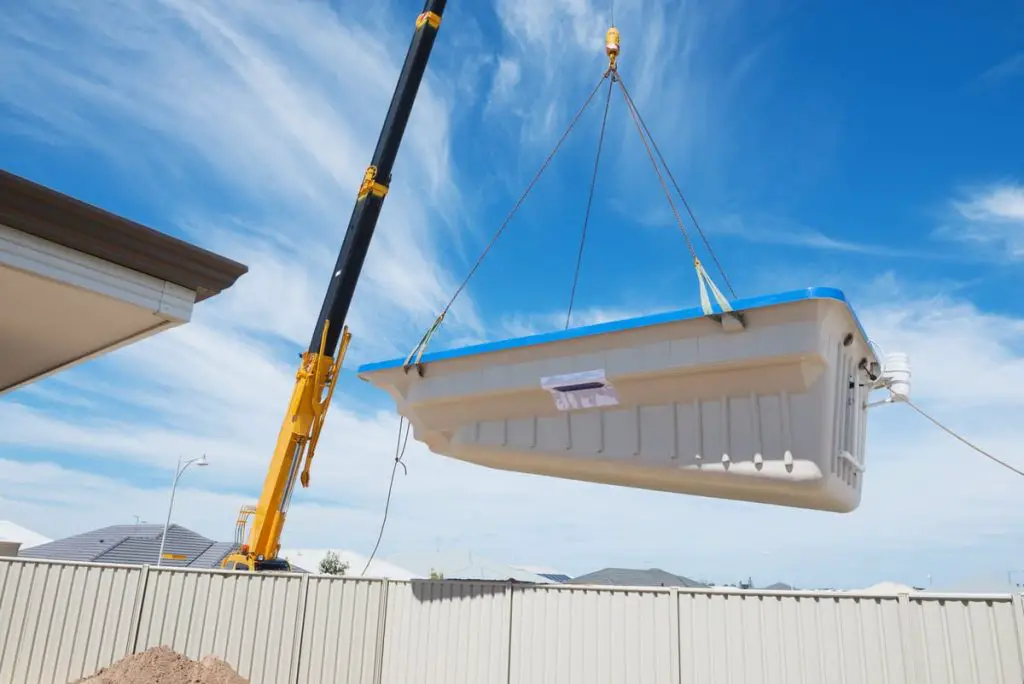If you’re living in Texas, you’re no stranger to the unbearably hot summers, and a pool seems like the perfect way to cool off while having fun. Fiberglass pools are an increasingly popular investment, but are fiberglass pools good in Texas?
Fiberglass pools are ideal in Texas because they are incredibly durable and resistant to both scorching and freezing temperatures. Additionally, the surface will not get damaged by algae growth, humid air, or sun exposure which are all prominent in Texas.
Installing your fiberglass pool is a significant investment, so you’ll need to know how much you should expect to pay. Read on for a further explanation on why fiberglass pools are ideal for the hot climate of Texas. Additionally, I’ll provide a breakdown of the average costs associated.

What Are Fiberglass Pools?
Unlike the other in-ground swimming pools (concrete and vinyl liner), a fiberglass pool is manufactured off-site and shipped to you in one piece. As the name suggests, the pool shell is made entirely from fiberglass material before being covered in several protective gel coats.
More homeowners are choosing to install fiberglass pools because they boost numerous advantages over concrete and vinyl liner pools, such as the following:
- The materials used for the protective coats make fiberglass pools naturally smooth and non-porous. Therefore, they are resistant to algae growth, which makes them easier to maintain in the long term.
- Fiberglass pools don’t take long to construct or install – you could have yours in as little as four to six weeks. Additionally, since the pool is built off-site, you won’t have to deal with the unsightly construction process that comes with installing a concrete or vinyl liner pool.
- They have extremely low maintenance requirements. There are no liner replacements or resurfacing requirements like you would have with liner and concrete pools.
Are Fiberglass Pools Suitable for Hotter Climates?
If you live in Texas’ sweltering climate, fiberglass is an excellent option for an in-ground swimming pool as it fares well in both extreme heat and cold conditions. Here are just some of the features that make fiberglass pools suitable for hotter climates.
- Fiberglass is chemically inert (i.e., It doesn’t react with other substances). As such, it is resistant to humid air and ultraviolet light from the sun.
- Harmful algae tend to grow more rapidly in summer, but a fiberglass pool’s non-porous surface keeps this to a minimum.
- Since fiberglass is so strong (approximately 17 times stronger than concrete), fiberglass pools are naturally heat-resistant. They are far less likely to warp and crack due to sun exposure.
This is not to say that fiberglass pools are not without drawbacks in hotter climates, just like any pool type. For example, prolonged sun exposure may cause the topcoat of the pool to fade and peel; however, this is merely an aesthetic issue and does not affect the pool’s structure. Additionally, the impact can be minimized by choosing a pool with one solid color throughout.
What About Colder Climates?
The widely perpetuated idea that fiberglass pools can’t be installed in colder climates is a myth. Indeed, the durability of fiberglass means these pools can withstand extreme temperatures on both sides of the scale.
The pool’s pipes will need to be “winterized” in freezing temperatures. You’ll want to do this so the pool water can freeze over without causing any structural damage. With the flexibility and strength of the fiberglass material, your pool is well-able to expand and contract without cracking (as it freezes and thaws).
Fiberglass is a natural insulator and absorbs less heat than concrete or vinyl, so the water heats up quickly and stays warm for longer. We tend to think of outdoor swimming as a summer activity. However, the fiberglass pool boasts many features that allow you to take a dip in the cold weather too!
Overall, it’s clear that fiberglass pools are an attractive option no matter what climate you live in. If you’re interested in installing one, you’ll want to know the approximate costs. So, let’s break down the cost of a fiberglass pool.
How Much Does a Fiberglass Pool Cost in Texas?
Many online resources will give you an overall rough cost without telling you how that price is calculated. I’m going to break down the cost, including the price of construction vs. installation. I will also cover how much you should expect to pay for individual features.
Note that the cost of your fiberglass pool can vary depending on its size, depth, and specific location. The numbers provided here are a rough estimate and should be verified with a local pool builder.

Manufacturing and Installation
Some fiberglass pool companies will offer an overall price for your pool’s manufacturing, delivery, and installation. However, hiring local builders to order and install it may save you a significant amount of money.
According to Home Advisor, the national average price of a fiberglass pool shell is $8,750, but it can range from $4,500-$30,000. Costs will depend on the desired size and depth of your pool. Additionally, it will depend on whether you wish to add extra features such as spas or tanning shelves.
If you don’t want the manufacturer to install the pool, your next best option is to look for local builders experienced in fiberglass pool installation. Typically, installing a fiberglass pool costs around $5.50 per square foot. Considering the average swimming pool measures 600 square feet, you can expect to pay approximately $3,300 for your fiberglass pool to be installed.
Additional Expenses
However, you’ll likely have to factor in other costs on top of this. For example:
- Layers of compacted stone may have to be added to the soil to create a stable base for your pool.
- If access to space is inhibited by trees and foliage etc., extra costs may apply to remove it.
- Bedrock/shale might need to be removed from the soil – a hydraulic hammer is required for this, and it can be costly and time-consuming.
The installation fees will often include setting up the required electrical and plumbing systems, but you should check with the company.
Decking
The deck is an essential part of any fiberglass pool. Having a nicely built deck will not only help your pool blend with its surroundings, but it also serves the vital purpose of giving you a safe surface from which to enter the water.
The price of your decking will depend on which material you use, but concrete decks are by far the most common. The average decking will cost anywhere from $4 to $20 per square foot.
Heat/Cooling Pumps
Heat pumps are a common addition to fiberglass pools, but a cooling pump (to maintain a specific water temperature) is probably a better option if you’re in Texas. They typically cost between $600 and $1,000.
Fencing
If you have children or small pets at home, fencing is vital to protect them. Again, the price will vary depending on which material you use, but you can expect to pay $13-$50 per linear foot and an extra $350-$500 for a gate.
Other Costs
You may wish to add optional extras that can enhance your pool’s aesthetic quality. These include:
- Salt systems
- Water features
- Lighting
- Jets
The price for such additions can vary widely, so you should check with the company you choose to install your pool if they can add these extras and for what price.
Overall, the total average cost of a fiberglass pool in Texas ranges from $15,000-$60,000.
You now have all the necessary information to decide whether or not a fiberglass pool is the right option for your home. Good luck!
